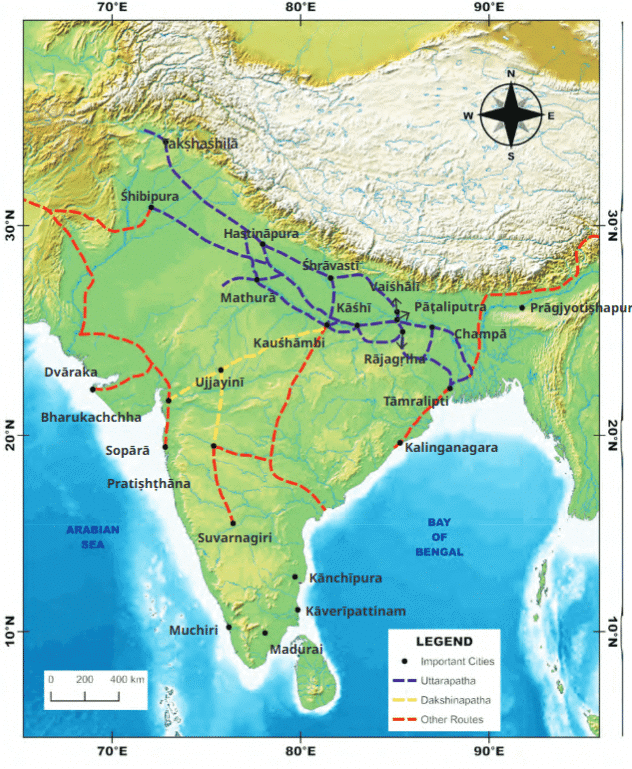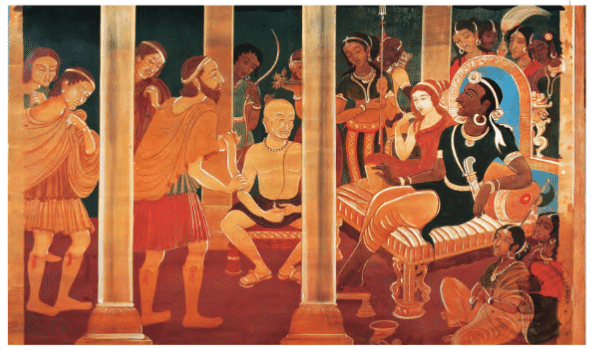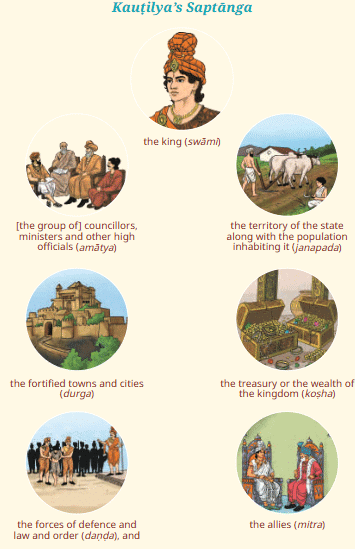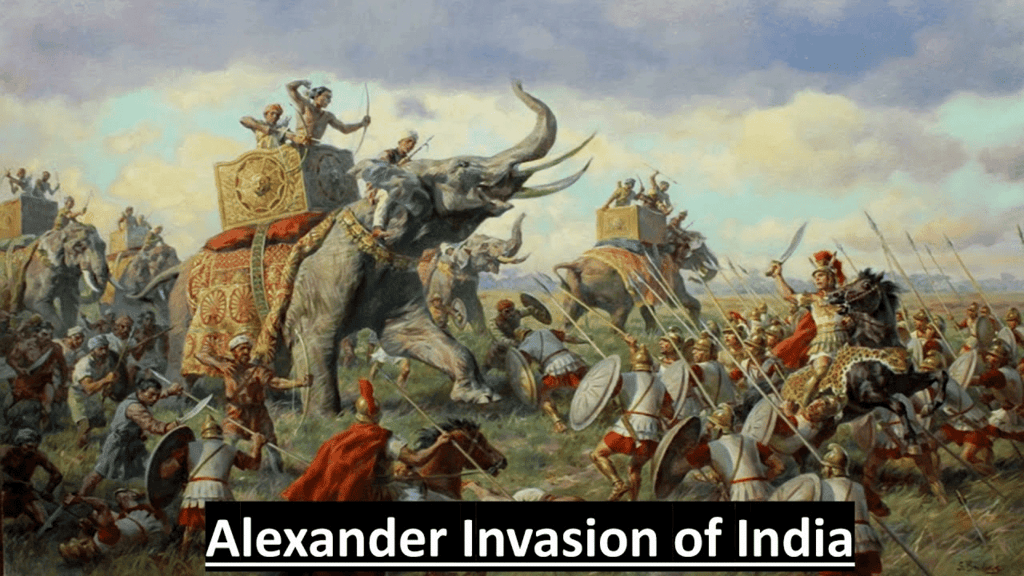Short Answer Questions

Q1: Why was trade important for building and maintaining an empire?
Ans: Trade brought in money through taxes and allowed empires to afford large armies, roads, and ships. It also helped people get goods from faraway places and made cities grow richer.
Trade Routes
Q2: How did guilds (shrenis) support trade and society in ancient India?
Ans: Guilds helped traders and craftsmen work together, share resources, and support each other. They had their own rules and leaders and were often free from king’s control as long as trade flourished.
Q3: What made Magadha a powerful kingdom before becoming an empire?
Ans: Magadha had fertile land, forests, rivers, and iron resources. These helped it grow crops, build weapons, and transport goods easily, making it a strong base for empire-building.
Q4: How did the use of iron help in the growth of empires like Magadha?
Ans: Iron tools increased food production, and iron weapons made armies stronger. This allowed rulers to conquer more land and support growing populations.
Q5: What happened when Alexander the Great invaded India?
Ans: Alexander fought and defeated King Porus but faced strong resistance. His soldiers refused to go further, and many died on the way back through deserts.
Q6: How did the meeting between Alexander and Indian sages show cultural exchange?
Ans: Alexander met Indian sages called Gymnosophists, who impressed him with their wisdom. This meeting showed that ideas and philosophies were shared between cultures.

Q7: What role did Megasthenes play in documenting the Mauryan Empire?
Ans: Megasthenes was a Greek ambassador in Chandragupta’s court. He wrote about India in his book Indika, describing cities, trade, and administration.
Megasthenes in the court of Chandragupta Maurya
Q8: Why did Chandragupta Maurya choose Pataliputra as his capital?
Ans: Pataliputra was located near rivers and trade routes. It had rich land, strong defenses, and was ideal for administration and expansion.
Q9: How did Kauṭilya help Chandragupta Maurya become emperor?
Ans: Kauṭilya used his knowledge of politics and economics to plan strategies. He supported Chandragupta in defeating the Nandas and uniting northern India.
Q10: What kind of government system did the Mauryas have?
Ans: The Mauryas had a centralized government with strict laws and a strong administration. Officials collected taxes, maintained order, and ensured people’s welfare.
Q11: How did Aśhoka spread Buddhism beyond India?
Ans: After the Kalinga War, Aśhoka sent messengers to Sri Lanka and Southeast Asia. He promoted Buddhist values of peace and kindness across Asia.
Q12: What were Aśhoka’s contributions to public welfare?
Ans: Aśhoka built rest houses, planted trees, and provided medical care. He banned hunting and sent officials to check on people’s well-being.
Long Answer Questions
Q1: How did trade routes contribute to the growth of empires like the Mauryas?
Ans:
- Trade routes connected distant regions, allowing goods, ideas, and culture to move freely.
- The Maurya Empire controlled key trade routes like Uttarapatha and Dakṣiṇapatha, increasing wealth through taxes on trade.
- This economic prosperity helped fund the army and infrastructure, enabling the empire to grow and maintain power.
- Trade also fostered cultural exchange, enriching the empire’s society.
Q2: Explain the role of warfare in the expansion of empires.
Ans:
- Warfare was a primary tool for expansion in ancient empires.
- Empires like the Mauryas used their armies, including elephants and iron weapons, to conquer smaller kingdoms.
- Conquering new lands provided more resources, including wealth, land, and manpower.
- However, the desire for control over trade routes and strategic locations also motivated warfare, often resulting in the incorporation of diverse cultures and territories.
Q3: What was the importance of the Saptanga concept in governance according to Kauṭilya?
Ans:
- The Saptanga concept, described by Kautilya in his Arthashastra, divides the state into seven parts: the king, ministers, territory, cities, army, treasury, and allies.
- These components worked together to ensure the kingdom’s prosperity and stability.
- The king’s leadership, supported by efficient administration and a strong army, was crucial for the protection and growth of the empire.
- The system helped in managing resources and dealing with external threats.

Kautilya’s Saptanga
Q4: How did Aśhoka’s policies reflect his commitment to peace and governance?
Ans:
- Aśhoka’s policies after the Kalinga War showed his transformation into a proponent of peace and non-violence.
- He embraced Buddhism and promoted moral governance through his edicts, encouraging kindness, tolerance, and welfare for all.
- His edicts called for respect toward all religions and the fair treatment of citizens.
- Aśhoka’s reforms, such as healthcare for people and animals, planted trees along roads, and promoted education, reflected his deep concern for the well-being of his empire.
Q5: How did the Maurya Empire ensure social and economic welfare?
Ans:
- The Maurya Empire focused on both social welfare and economic stability.
- Farmers were protected during wars, ensuring food production continued.
- The Mauryas also introduced a strong taxation system to fund public works, maintain the army, and promote trade.
- Artisans and merchants played a key role in the economy, and cities had markets, public buildings, and services like fire protection and water supply.
- The empire’s governance model ensured the stability of both the economy and society.
Q6: Discuss the impact of Alexander’s invasion on India.
Ans:
- Alexander’s invasion in 327-325 BCE had a limited long-term political impact but led to significant cultural exchanges.
- While Alexander defeated King Porus, he was unable to move further into India due to his soldiers’ reluctance.
- Greek influence spread, especially in art, philosophy, and governance.
- His brief rule left satraps (governors) in control of northwest India, which later contributed to Indo-Greek cultural interactions and the spread of Hellenistic ideas.

Q7: What were the main challenges faced by empires like the Mauryas after the death of strong rulers like Aśhoka?
Ans:
- After Aśhoka’s death, the Maurya Empire faced internal conflicts, weak rulers, and loss of control over distant regions.
- The lack of strong leadership and central authority led to revolts and the gradual fragmentation of the empire.
- Smaller kingdoms gained independence, and the empire’s unity weakened.
- The vast size of the empire also made it difficult to control, leading to a breakdown in the administration and defense, which contributed to its decline.
Q8: How did the development of art and architecture during the Mauryan period influence later Indian culture?
Ans:
- Mauryan art and architecture laid the foundation for later cultural developments.
- The construction of stūpas, pillars, and edicts under Aśhoka’s rule set standards for architectural design and Buddhist symbolism.
- The Sarnath pillar, with its four lions, became India’s national emblem.
- These artistic traditions continued to influence Indian architecture in subsequent empires.
- The Mauryan period’s cultural achievements remain a lasting legacy in India’s art history.